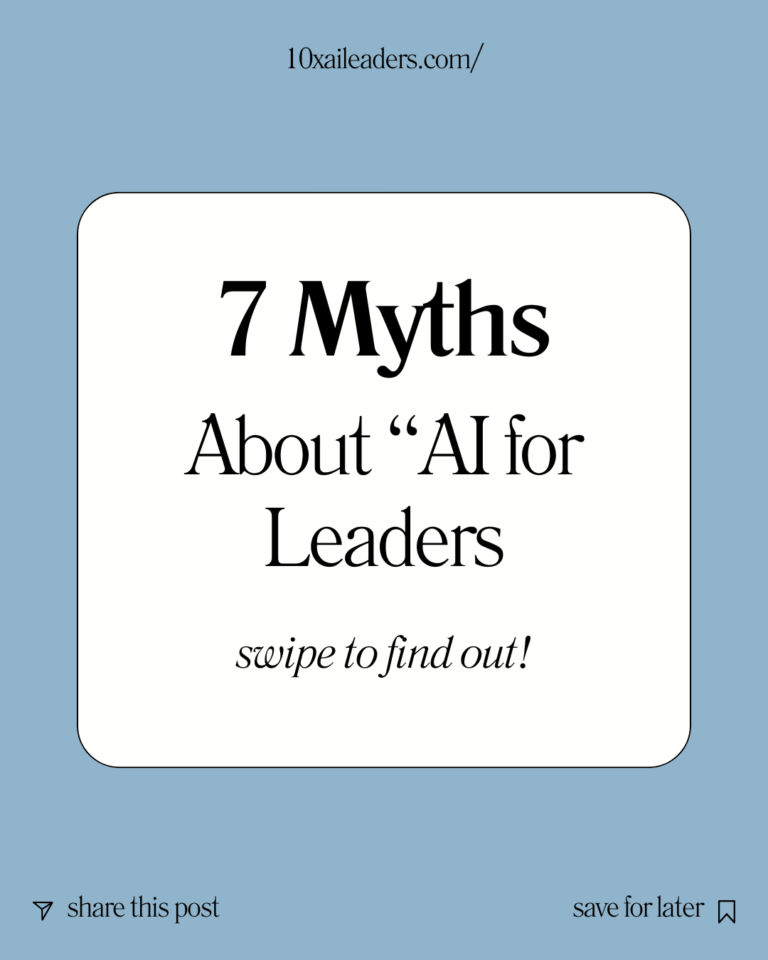Artificial intelligence has quickly moved from being a futuristic idea to a daily business tool. Yet, despite its rapid adoption, many senior leaders remain hesitant about how to use it effectively. This hesitation often comes from myths and misconceptions about AI—ideas that create unnecessary fear or unrealistic expectations. In 2025, where AI adoption is not optional but essential, AI for leaders becomes a critical priority. Leaders, managers, and HR professionals who understand the truth about AI will be better prepared to make smarter, data-driven decisions and future-proof their organizations.
Below, we’ll bust seven common myths about “AI for leaders” and explain what decision-makers really need to know.
Myth 1: AI Will Replace Leaders
One of the biggest fears is that AI will make leadership roles obsolete. This isn’t true. AI is a tool, not a replacement for human judgment.
While AI can analyze data, optimize schedules, or predict trends, it cannot replace empathy, creativity, or vision—the qualities that define strong leadership. Leaders who learn how to use AI can actually enhance their role, freeing time from repetitive tasks to focus on strategic priorities.
Reality: AI empowers leaders to make smarter decisions, not irrelevant ones.
Myth 2: AI Is Only for Tech Companies
Another misconception is that AI belongs only in Silicon Valley or technology-driven organizations. In reality, every industry is finding practical uses for AI.
Retailers use AI to personalize customer experiences.
Healthcare providers rely on AI for diagnostics and patient management.
Manufacturers use AI to optimize supply chains and reduce downtime.
Reality: Whether you’re in finance, education, or manufacturing, AI workshops and training can help leaders identify practical, non-technical ways to apply AI within their organizations.
Myth 3: You Need to Be a Data Scientist to Use AI
Many managers assume that AI requires deep technical knowledge. While expertise is helpful, leaders don’t need to become coders or data scientists. Instead, they need to develop an AI mindset—understanding what AI can and cannot do, asking the right questions, and knowing how to leverage the right tools.
Reality: AI for managers is about learning to lead teams that use AI, not building the algorithms themselves
Myth 4: AI Is Too Expensive for Most Companies
It’s true that early AI systems were costly and resource-heavy. But today, AI tools are accessible and affordable—even for small and mid-sized businesses. Cloud-based platforms and subscription models make it possible for organizations to experiment with AI without huge upfront investments.
Reality: AI is no longer just for corporations with deep pockets. With the right AI training, leaders can identify affordable tools that deliver measurable business impact.
Myth 5: AI Makes Decisions for You
Some believe that AI takes control away from leaders. In truth, AI provides recommendations, insights, and predictions—but the final decision remains with people. For example, AI might highlight which employees are at risk of burnout, but it’s up to managers to decide how to support them.
Reality: AI enhances decision-making but does not replace accountability.
Myth 6: AI Is a Short-Term Trend
Skeptics often dismiss AI as a passing fad. Yet, AI has already proven its staying power, with adoption rates climbing across industries. Analysts project that by 2030, AI will contribute trillions to the global economy.
Reality: AI is not a temporary trend. Leaders who invest in AI workshops and training today will have a long-term competitive advantage.
Myth 7: AI Dehumanizes the Workplace
Another common myth is that AI will strip away human interaction. In reality, AI can do the opposite. By automating repetitive tasks, leaders and managers can spend more time building relationships, mentoring teams, and focusing on culture.
Reality: AI allows leaders to be more human, not less.

Why Busting These Myths Matters for Leaders
When leaders cling to misconceptions, they risk falling behind competitors who are already leveraging AI for efficiency, innovation, and employee engagement. Understanding the realities of AI helps leaders:
Build confidence in using AI strategically.
Communicate its value to teams.
Design training programs that integrate AI into daily workflows.
Forward-thinking organizations are already investing in AI training for managers and leaders. These investments ensure that decision-makers not only understand AI but also lead with clarity in a digital-first world.
Conclusion
AI is no longer a distant idea—it’s a leadership necessity in 2025. But to unlock its full potential, leaders must move past outdated myths. From fears about job loss to assumptions about cost, the truth is that AI is a partner, not a threat.
The leaders who embrace AI workshops and invest in AI training will be the ones who drive growth, foster innovation, and create resilient organizations for the future.
Are you ready to empower your leadership team with AI skills? Join one of our upcoming AI workshops or book a consultation to start building AI confidence today.
FAQs on AI For Leaders
What skills do leaders need to work with AI?
Leaders need strategic thinking, data literacy, and an understanding of how AI impacts decision-making. They don’t need technical coding skills but should learn how to guide teams using AI.
Is AI training necessary for managers?
Yes. AI training helps managers understand how to apply AI to workflows, improve team productivity, and make data-driven decisions.
How do AI workshops benefit leaders?
AI workshops provide hands-on learning, practical examples, and frameworks to help leaders identify where AI can add value in their organizations.
Can small businesses benefit from AI?
Absolutely. Affordable AI tools are available for small businesses, from customer service chatbots to predictive analytics for sales and operations.
